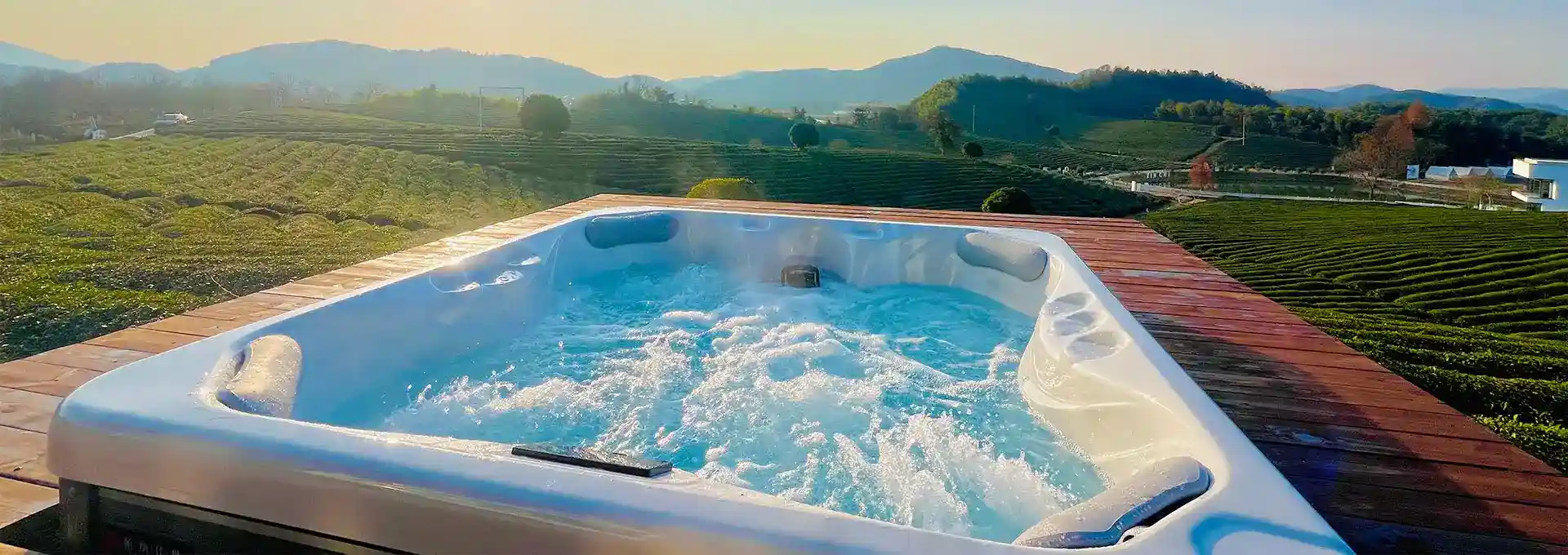How to Prep for Inground Swim Spa?
2024-12-19 16:54:11
Preparing for an inground swim spa is an exciting endeavor that requires careful planning and consideration. These versatile aquatic installations combine the benefits of a swimming pool and a spa, offering a compact solution for exercise, relaxation, and hydrotherapy. Whether you're looking to enhance your fitness routine or create a backyard oasis, proper preparation is key to ensuring a successful installation and long-term enjoyment of your swim spa.
What are the essential site preparation steps for an inground swim spa?
Site preparation is a crucial phase in the installation of an inground swim spa. This process involves several key steps to ensure that your chosen location is ready to accommodate the structure and its supporting systems. Here's a comprehensive guide to the essential site preparation steps:
- Site Assessment: Begin by thoroughly evaluating the proposed location for your inground swim spa. Consider factors such as soil composition, drainage patterns, and proximity to utilities. It's advisable to consult with a professional landscaper or engineer to assess the site's suitability and identify any potential challenges.
- Permits and Regulations: Research and obtain all necessary permits required by your local municipality. This may include building permits, electrical permits, and potentially zoning approvals. Familiarize yourself with local regulations regarding setbacks, fencing requirements, and any other specific guidelines for inground installations.
- Excavation: Once you have the green light, proceed with excavation. The hole should be slightly larger than the dimensions of your chosen swim spa to allow for proper installation and access. Pay attention to depth requirements, which may vary depending on the model and local building codes.
- Foundation Preparation: A solid foundation is critical for the longevity and stability of your inground swim spa. This typically involves pouring a concrete slab that's level and capable of supporting the weight of the filled spa and its occupants. Ensure proper reinforcement and thickness as per manufacturer specifications and local building codes.
- Drainage System: Install a comprehensive drainage system around the perimeter of the excavation. This helps prevent water accumulation and potential damage to the structure. Consider incorporating a French drain or similar system to direct water away from the spa area.
- Utility Connections: Plan and install the necessary utility connections, including electrical, plumbing, and potentially gas lines if your model requires heating. Work with licensed professionals to ensure all connections meet safety standards and local codes.
- Access Planning: Consider how the swim spa will be delivered to the site. Ensure there's adequate clearance for equipment and that the path to the installation area can support heavy machinery if required.
- Surrounding Area Preparation: Prepare the area around the future swim spa for landscaping, decking, or patio installation. This may involve grading the surrounding land, installing retaining walls if necessary, and planning for seamless integration with your existing outdoor space.
By meticulously following these site preparation steps, you'll create a solid foundation for your inground swim spa, ensuring its proper installation and optimal performance for years to come.
How much does it cost to install an inground swim spa?
The cost of installing an inground swim spa can vary significantly based on several factors. Understanding these variables can help you budget effectively and make informed decisions about your investment. Here's a detailed breakdown of the costs associated with inground swim spa installation:
Factors Influencing Cost:
- Swim Spa Model and Size: The price of the swim spa unit itself is a major component of the overall cost. Prices can range from $20,000 to $50,000 or more, depending on the size, features, and brand. Larger models with advanced features like powerful jets, integrated sound systems, or smart controls will be at the higher end of the spectrum.
- Site Preparation: Costs for excavation, grading, and foundation work can vary based on your property's characteristics. Expect to pay between $3,000 to $10,000 for site preparation, with complex terrains or difficult access potentially increasing this cost.
- Installation: Professional installation is crucial and can cost between $5,000 to $15,000. This includes crane rental for placing the spa, connecting utilities, and ensuring proper setup.
- Electrical Work: You'll need a dedicated electrical circuit for your swim spa. Electrical installation can range from $1,000 to $5,000, depending on the complexity of the work and the distance from your main electrical panel.
- Plumbing: Proper plumbing installation is essential for the spa's functionality. This can cost between $1,500 to $4,000, depending on the distance to existing water lines and the complexity of the installation.
- Permits and Inspections: Budget $500 to $2,000 for necessary permits and inspections, which vary by location.
- Landscaping and Finishing: After installation, you may want to enhance the surrounding area with decking, paving, or landscaping. This can add $5,000 to $20,000 or more to your project, depending on the extent of the work.
- Additional Features: Optional extras like covers, lighting, water features, or heating systems can add $2,000 to $10,000 to the total cost.
Total Cost Estimate:
Considering these factors, the total cost for installing an inground swim spa typically ranges from $40,000 to $100,000 or more. Here's a rough breakdown:
- Low-end installation: $40,000 - $60,000
- Mid-range installation: $60,000 - $80,000
- High-end installation: $80,000 - $100,000+
It's important to note that these are estimates, and actual costs can vary based on your specific circumstances, location, and chosen features. To get a more accurate estimate, consider the following steps:
- Obtain quotes from multiple reputable swim spa dealers and installers in your area.
- Request detailed breakdowns of costs to understand what's included in each quote.
- Factor in long-term costs such as maintenance, energy consumption, and potential repairs.
- Consider financing options if available, as many dealers offer payment plans or financing solutions.
While the initial investment may seem substantial, many homeowners find that an inground swim spa adds significant value to their property and lifestyle. By carefully planning your budget and choosing options that align with your needs and preferences, you can create a luxurious and functional aquatic retreat that provides years of enjoyment and wellness benefits.
What are the best features to look for in an inground swim spa?
When selecting an inground swim spa, it's essential to consider features that will enhance your experience and meet your specific needs. The best features can vary depending on your intended use, whether it's primarily for exercise, relaxation, or a combination of both. Here's a comprehensive guide to the top features to look for in an inground swim spa:
1. Powerful Swim Current System
A robust swim current is crucial for those looking to use the spa for swimming and exercise. Look for models with:
- Multiple, adjustable jets that create a wide, deep current
- Variable speed settings to accommodate different skill levels
- Smooth, laminar flow for a more natural swimming experience
- Advanced propulsion systems that reduce turbulence
2. Spacious Swimming Area
Ensure the swim spa offers enough space for comfortable swimming and exercise:
- Look for models with lengths of at least 14 feet for adequate stroke room
- Consider wider models (7-8 feet) for more comfortable swimming
- Check the depth to ensure it's suitable for your height and swimming style
3. Hydrotherapy Jets
For relaxation and therapeutic benefits, prioritize models with:
- Multiple, strategically placed massage jets
- Adjustable jet pressure for customized massage experiences
- Targeted therapy zones for specific muscle groups
- Ergonomically designed seating for comfort during hydrotherapy sessions
4. Energy Efficiency
To minimize operating costs and environmental impact, look for:
- High-quality insulation in the shell and cabinet
- Energy-efficient pumps and heaters
- LED lighting options
- Smart controls for optimized energy management
5. Durable Construction
Invest in a swim spa built to last:
- Acrylic shell reinforced with fiberglass for strength and durability
- High-quality, weather-resistant cabinet materials
- Sturdy, corrosion-resistant frame
- UV-resistant surfaces to prevent fading and deterioration
6. Advanced Filtration and Water Management
Ensure clean, healthy water with:
- Multi-stage filtration systems
- Ozone or UV-C sanitization for reduced chemical dependency
- Automated water care systems for easier maintenance
- Efficient skimming and circulation systems
7. Temperature Control
Look for features that offer versatile temperature management:
- Rapid heating capabilities
- Precise temperature control systems
- Options for maintaining different temperatures in swim and spa areas (in dual-temperature models)
- Energy-efficient heating elements
8. User-Friendly Controls
Opt for intuitive control systems:
- Easy-to-use touchscreen panels
- Smartphone app integration for remote control
- Programmable settings for personalized experiences
- Clear display of water temperature, chemical levels, and system status
9. Safety Features
Prioritize models with built-in safety measures:
- Non-slip surfaces on steps and seating areas
- Handrails or grab bars for easy entry and exit
- Automatic shut-off features for pumps and heaters
- Child-safety locks on covers
10. Aesthetic Options
Choose features that complement your outdoor space:
- Variety of shell and cabinet color options
- Customizable lighting systems, including underwater LEDs
- Waterfall or fountain features for added ambiance
- Compatibility with surrounding landscaping and decking
When evaluating these features, consider your primary goals for the swim spa. If fitness is your main objective, prioritize a powerful swim current and spacious swimming area. For relaxation and therapy, focus on hydrotherapy jets and comfort features. Many high-end models offer a balance of these elements, providing versatility for various uses.
Remember that the best features for you will depend on your personal preferences, budget, and intended use of the swim spa. It's advisable to test different models if possible and consult with reputable dealers to find the perfect combination of features that meet your needs and enhance your inground swim spa experience.
For more information on hot tub installations and to find out more about our products, please feel free to contact us at info@iparnassus.com.
References
- Swim Spa Guide. (2021). "How to Prepare for a Swim Spa Installation." SwimSpaGuide.com
- Home Advisor. (2022). "How Much Does It Cost To Install An Inground Swim Spa?" HomeAdvisor.com
- Swim University. (2021). "The Ultimate Guide to Buying a Swim Spa." SwimUniversity.com
- Pool Research. (2022). "Inground Swim Spa Installation: What You Need to Know." PoolResearch.com
- Aqua Magazine. (2021). "The Rise of the Swim Spa." AquaMagazine.com
- Landscaping Network. (2022). "Swim Spa Installation Guide." LandscapingNetwork.com
- Spa Depot. (2021). "Choosing the Right Swim Spa: Features to Consider." SpaDaepot.com
- Pool and Spa News. (2022). "Energy Efficiency in Swim Spas." PoolAndSpaNews.com
- Backyard Leisure. (2021). "Top Features of Modern Swim Spas." BackyardLeisure.com
- Swim Spa Reviews. (2022). "Comparing Inground vs. Above-Ground Swim Spas." SwimSpaReviews.com
Send Inquiry
Related Industry Knowledge
- Are Chemicals Making My Hot Tub Foamy?
- Does Homeowners Insurance Cover Hot Tub?
- What is a Swim Spa?
- Why do spa air control valves leak?
- Is Hot Tub Therapy Good for Bad Back?
- How Much is a Swim Spa Hot Tub Combo?
- How Much is a 5 Person Hot Tub?
- How Many People Does It Take to Move a 6-Person Hot Tub?
- How Much to Install a Swim Spa Inground?
- Can I Empty Hot Tub on Grass?



